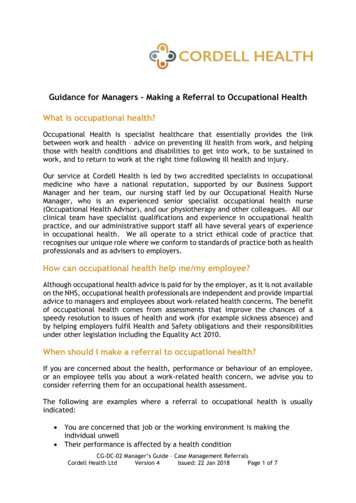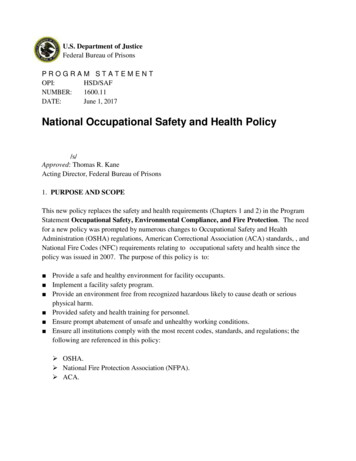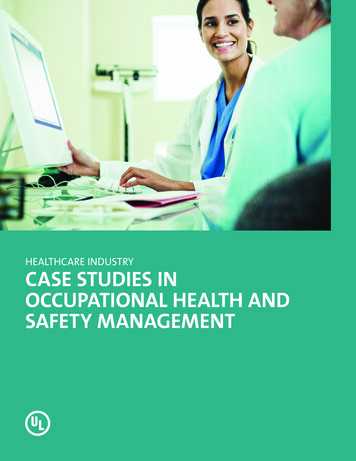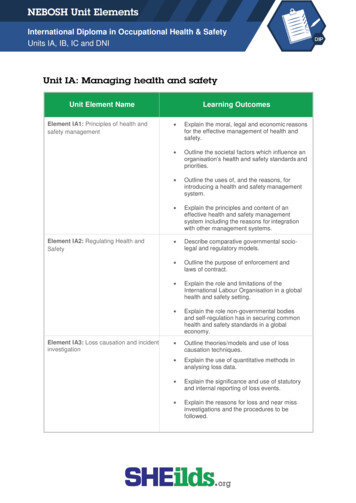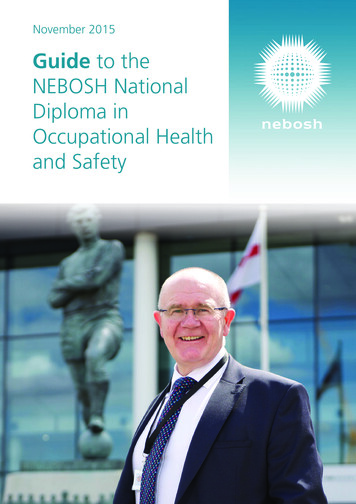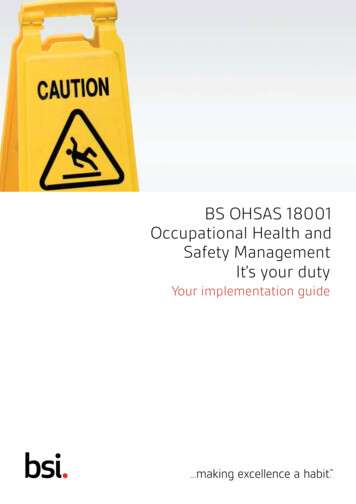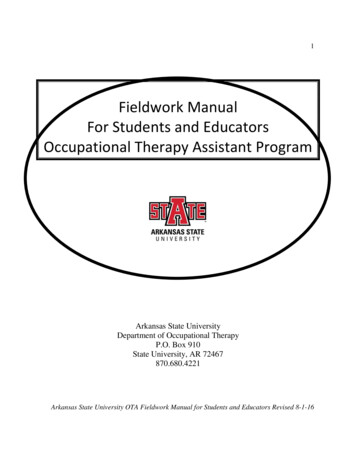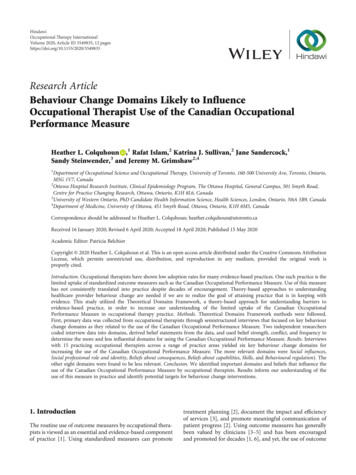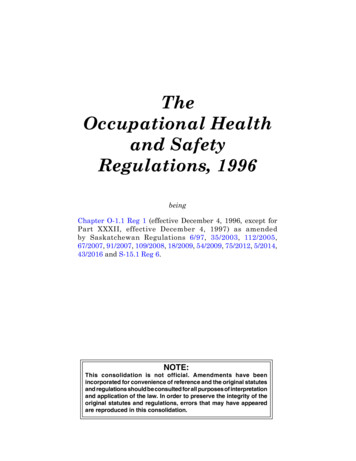
Transcription
1OCCUPATIONAL HEALTH AND SAFETY, 1996O-1.1 REG 1TheOccupational Healthand SafetyRegulations, 1996beingChapter O-1.1 Reg 1 (effective December 4, 1996, except forPart XXXII, effective December 4, 1997) as amendedby Saskatchewan Regulations 6/97, 35/2003, 112/2005,67/2007, 91/2007, 109/2008, 18/2009, 54/2009, 75/2012, 5/2014,43/2016 and S-15.1 Reg 6.NOTE:This consolidation is not official. Amendments have beenincorporated for convenience of reference and the original statutesand regulations should be consulted for all purposes of interpretationand application of the law. In order to preserve the integrity of theoriginal statutes and regulations, errors that may have appearedare reproduced in this consolidation.
2O-1.1 REG 1123456OCCUPATIONAL HEALTH AND SAFETY, 1996Table of ContentsPART IPreliminary MattersTitleInterpretationRepealedGiving notice to divisionGenerality of duties not limitedCertification by professional engineerPART IINotice Requirements7 New operations8 Accidents causing serious bodily injury9 Dangerous occurrences10 Medical information11 Report re injuriesPART IIIGeneral Duties12General duties of employers13General duties of workers14Employment of young persons15Duty of employer or contractor to provideinformation16Duty of contractor to inform17Supervision of work18Duty to inform workers19Training of workers20Workers’ contacts with officers21Biological monitoring22Occupational health and safety program23Examination of plant24Identifying mark of approved equipment25Maintenance and repair of equipment26Boilers and pressure vessels27Prohibition re use of compressed air28Inspection of place of employment29Investigation of certain accidents30Prohibition re scene of accident31Investigation of dangerous occurrences32Injuries requiring medical treatment33Work where visibility is restricted34Work or travel on ice over water, etc.35Working alone or at isolated place of employment36Harassment37Violence37.1 Safety measures – retail 5960616263PART IVCommittees and RepresentativesCommittees at construction sitesDesignation of committee membersQuorum and certain votesFrequency of meetingsMinutesCo-chairpersonsSpecial meetingsDesignation of representativeTraining of representatives, committee membersMeetings of employers and representativesOpportunity for necessary activitiesMeetings called by officerPART VFirst AidInterpretationApplicationProvision of first aidMore than one employerFirst aid personnelCertificatesFirst aid stationFirst aid registerFirst aid roomWorkers being transportedFirst aid supplies and equipmentTransportation of injured workersAsphyxiation and poisoningAdditional 106107108109110111112113114PART VIGeneral Health RequirementsSanitationVentilation and air supplyMechanical ventilationCleaning and maintaining ventilation systemsSpaceLightingThermal conditionsToilet facilitiesPersonal washingClothingChange and shower facilitiesEating areasDrinking waterSmokingLifting and handling loadsStandingSittingMusculoskeletal injuriesShift work and constant effort and exertionVisually demanding tasksRadioactive substancesExposure control planPART VIIPersonal Protective EquipmentUse of equipment requiredGeneral responsibilitiesRespiratory protective devicesInspection of respiratory protective devicesWorking in dangerous atmospheresProtective headwearWorkers using all terrain vehicles, snowmobiles, etc.Eye and face protectorsSkin protectionLower body protectionFootwearHand and arm protectionExposure to hazardous substancesExposure to noiseRepealedLifelinesPersonal fall arrest systemsFull-body harnessSnap hooks on personal fall arrest systemLanyardsWorkers’ responsibilities re lifelines, etc.Inspection of full body harness, etc.Protection against drowningPART VIIINoise Control and Hearing ConservationGeneral dutyNoise reduction through design, constructionof buildingsMeasurement of noise levelsHearing protection requiredDaily exposure greater than 85 dBA LexHearing conservation planPART IXSafeguards, Storage, Warning Signs and Signals115 Interpretation116 Protection against falling116.1 Fall protection plan116.2 Control zone116.3 Anchor Points and Anchor Plates117 Elevated conveyors118 Wire mesh119 Protection against falling objects120 Protection from objects falling from scaffolds, etc.121 Handrails122 Guardrails123 Toeboards124 Openings in floors, roofs, etc.125 Building shafts126 Safety nets
43144145146147148149150151152Storage tanksOCCUPATIONALMounting of tiresStorage of materialsPallets and storage racksPressurized hosesDesignated signallersRisk from vehicular trafficErectionof masonrywallHEALTH197ANDSAFETY,1996PART XMachine SafetyOperation by workersOperating controlsUnattended and suspended machinesSafeguardsWarning systemsLocking outCleaning, etc., of machine or other equipmentin motionBeltsAir-actuated fastening toolsExplosive-actuated fastening toolsAirless spray unitsGrinding machinesChain sawsCircular sawsPower-fed circular sawsBand-sawsCut-off sawsPushblocks and pushsticksHand-fed planers and joinersPART XIPowered Mobile Equipment153 Interpretation154 Trained operators for powered mobile equipment155 Visual inspection156 Inspection and maintenance157 Requirements for powered mobile equipment157.1 Construction, repair, etc., of powered mobileequipment158 Use of seat-belt or restraint by operator159 Protection against shifting of load160 Warning of reverse motion161 Roll-over protective structures162 Transparent materials used in cabs, etc.163 Fuel tanks in enclosed cabs164 Dangerous movements165 Transporting workers166 Ladders attached to extending boom167 ForkliftsPART XIIScaffolds, Aerial Devices, Elevating WorkPlatforms and Temporary Supporting Structures168 Interpretation169 Scaffold required170 Prohibition171 Limited use of certain scaffolds172 General requirements173 Ropes in scaffolds174 Scaffold planks and platforms175 Wooden scaffolds176 Metal scaffolds177 Heavy-duty scaffolds, scaffolds used atcertain heights178 Half-horse scaffolds179 Bracket scaffolds180 Ladderjack scaffolds181 Single-pole scaffolds182 Outrigger scaffolds183 Suspended scaffolds184 Suspended powered scaffolds185 Tie-in guides186 Use of suspended powered scaffolds187 Workers’ responsibilities188 Rolling scaffolds189 Shinglers’ roofing scaffold190 Crawl boards, roof ladders191 Prohibition192 Aerial devices and elevating work platforms193 Maintenance and inspection194 Forklifts195 Temporary supporting structures196 Flyform deck panels198 Erection of skeleton 29230231232233234235236237238239O-1.1 REG 1PART XIIIHoists, Cranes and Lifting DevicesInterpretationApplication of PartGeneral requirementsAdoption of standardsLoad ratingsDesignated operatorOperating proceduresRated loadRaising and lowering workersDetermining weight of loadOverload switchesDesignated signallerGeneral requirements for cranes and hoistsHoists, cranes with outriggers, etc.Operators’ cabs on tower cranesErecting and dismantlingLog bookInspectionsRepairsFriction type hoistsMaterial hoistsTower hoistsRoofers’ hoistsVehicle hoistsHand-operated hoistsWinchesA-frames and gin polesPile-driving equipmentPART XIVRiggingInterpretationGeneral requirementsInspectionMaximum loadsSlingsShacklesSheaves, spools and drumsKnots, wire rope clipsEye loopsHooksWedge socketsWire ropeRotation or motion of loadPART plication of PartSafe work practices and proceduresGeneral requirementsSafeguardsControlsProtection during maintenance or repairProtection during teaching248249250251252253254255256PART XVIEntrances, Exits and LaddersGeneral duty re entrances, exitsDoorsTravelwaysStairsLaddersPortable laddersUse of portable laddersFixed laddersConstruction ladders257258259260261262263264265PART XVIIExcavations, Trenches, Tunnels andExcavated ShaftsInterpretationApplication of PartLocating underground pipelines, etc.Excavating and trenchingTemporary protective structuresProtection against cave-in of excavationsProtection against cave-in of trenchesExcavated shafts and tunnelsBoreholes, belled areas of excavated shafts
4O-1.1 REG 1OCCUPATIONAL HEALTH AND SAFETY, 1996271272273274275PART XVIIIConfined Space EntryInterpretationIdentification of confined spaces, hazards, etc.Avoidance of entry into hazardous confined spaceRequirements before confined space is enteredRequirements before hazardous confinedspace is enteredNotice where no hazard foundEntry planPurging and ventilating of unsafe atmospherePrecautions where safe atmosphere not possiblePiping discharging hazardous substances276277278279280281282PART XIXWork in Compressed AirInterpretationApplication of PartBefore work in compressed air beginsWorkers in working chamberStandards for airMaximum air pressureWorking periods and rest 97298299300301PART XXDiving OperationsInterpretationCompetent workersStandardsMedical examinationDiving supervisorMinimum crewStandby diverDiver’s tenderBreathing gasDiving equipmentEquipment for diving baseHyperbaric chamberDiving planGeneral responsibilities of diverDiver’s personal logBuddy systemFree swimming divingScuba divingSurface-supply 1312313314PART XXIChemical and Biological SubstancesGeneral duties of employersList of chemical and biological substancesPrecautions for certain substancesSubstances listed in Table 19Substances listed in Table 20Substances listed in Table 21Protection of certain workersRespiratory protective devicesAccumulations, spills and leaksReport of worker’s exposureEmergency showersEye flushing equipmentFlammable, unstable, highly reactive andcorrosive substancesPART XXIIControlled Products – Workplace HazardousMaterials Information System315 Repealed316 Repealed317 Repealed318 Repealed319 Repealed320 Repealed321 Repealed322 Repealed323 Repealed324 Repealed325 Repealed326 Repealed327 Repealed328 Repealed329 RepealedPART 42343344345InterpretationApplication of PartProhibition re crocidoliteProhibition re sprayingIdentification of asbestos-containing materialsLabelling, placarding, etc.InspectionAsbestos processesAsbestos surfacesVentilation equipmentPersonal protective equipmentAsbestos wasteWarning of health risksTrainingHigh risk asbestos processesMedical 8PART XXIVSilica Processes and Abrasive BlastingInterpretationApplication of PartWarning of workersCleaning of blasting equipment, etc.Cleaning of worksitesSilica processes other than abrasive blastingIsolation from air containing dustPersonal protective equipmentStandards for blasting enclosuresUse of blasting enclosuresSandblastingSilica flourMedical examinations369370371372373374PART XXVFire and Explosion HazardsInterpretationFire safety planFire extinguishersGarbage as fire hazardProcedures for flammable substancesReceptacles for materials contaminated byflammable liquidsReceptacles for combustible or flammable liquidsHazardous activities involving combustible orflammable liquidsControl of ignition sources, static chargesFlammable liquids, gases or explosive substancesin vehiclesFlammable or explosive substance in atmosphereHot workCompressed and liquified gas systemsOxygenGas burning and welding equipmentPiping375376377378379PART XXVIExplosivesApplication of PartQualifications of workersWritten proceduresEquipmentStorage and transportation of explosives380381382383384385386387388PART XXVIIDemolition WorkInterpretationBefore demolition beginsStability of adjacent structuresRequirements re workersDemolition proceduresMaterial chutesStructural membersUse of powered mobile equipmentUse of explosives389390391392393PART XXVIIIForestry and Mill OperationsInterpretationApplication of PartFirst aid attendantCutting and skidding – general requirementsCutting359360361362363364365366367368
5OCCUPATIONAL HEALTH AND SAFETY, 2443444445446447448449FellingPartially cut treesLodged treesMechanized fellers and limbersBucking and limbingSkiddingSkidder operators’ responsibilitiesLoading, unloading and hauling logsVehicles used to haul logsLog carriagesSawmill head rigsTrimmer sawsEdgersBandsawsFeedrolls of resawsDry kilnsPART XXIXOil and GasInterpretationApplication of PartSupervisorsDaily tour bookRoutine inspectionsGeneral requirements re design, etc., of rigFlush-by and swabbing unitsSecuring parts of rigRaising and lowering derricksRig sites and foundationsGuy linesPlatforms, ladders and stairwaysMeans of escapeFull-body harnessFuel storagePressure relief devicesCatheadsSpudding inOperating controlsTravelling blocksCounterweightsWeight indicatorsDrawworksDrill pipes, tubing, etc.Material racksRotary tongsRotary tablesExits from enclosuresRig tanks or pitsDrill stem testingSwabbingWell operation and servicingWell stimulationShot holesGas sample containersPiping systems at well sitesBreathing apparatusFirst aid attendantsProcedures for flare tips, etc.Plan for well testingPART XXXAdditional Protection for Electrical Workers450 Interpretation451 Electrical workers452 Electrical equipment453 Covers for switches, receptacles, connections, etc.454 Electrical equipment in tunnel or manhole455 Luminaires456 Extension and power supply cords457 Portable power cables and cable couplers458 Portable luminaires459 Exposed metal parts460 Portable electric power plants461 Electrical panels462 High voltage switchgear and transformers463 Fire extinguishers464 Grounding of equipment before work begins465 Proximity to exposed energized high voltageelectrical conductors466 Exposed energized electrical conductors operatingat certain voltages467 Emergency programO-1.1 REG 1PART XXXIAdditional Protection for Health Care Workers468 Interpretation469 Application of Part469.1 Additional requirements re supervisors in healthcare facilities470 Patient moving and handling471 Cytotoxic drugs472 Waste473 Equipment contaminated with waste474 Waste needles, etc.474.1 Selecting needle-safe devices474.2 Injury log475 Contaminated laundry476 Anaesthetic gases477 Ethylene oxide sterilizers478 Review of programs, etc.479480481482483484485486487488489490491PART XXXIIAdditional Protection for Fire FightersInterpretationApplication of PartPlan for response to emergency incidentTraining of fire fightersGeneral standards for vehicles and equipmentSecuring of equipment, etc., in vehiclesInspection of firefighting vehicles and equipmentRepair of firefighting vehiclesTransportation of fire fightersPersonal protective equipmentInterior structural firefightingPersonal alert safety systemSafety ropes, harnesses and hardwarePART XXXIIIRepeal, Transitional and Coming into Force492 R.R.S. c.O-1.1 Reg 1 repealed493 Transitional494 Coming into forceAppendixMinimum Requirements for Class AQualificationTable 2 First Aid Services Authorized by Class AQualificationTable 3 Minimum Requirements for Class BQualificationTable 4 First Aid Services Authorized by Class BQualificationTable 5 Asbestos ProcessesTable 6 Notifiable Medical Conditions Resulting fromOccupation ExposureTable 7 Prescribed Places of EmploymentTable 8 Activities That Constitute High Hazard WorkTable 9 Summary of First Aid RequirementsTable 10 Required Contents of First Aid BoxTable 11 Additional Supplies and Equipment – Class AQualificationsTable 12 Additional Supplies and Equipment – Class BQualificationsTable 13 Minimum Numbers of Toilet FacilitiesTable 14 RepealedTable 14.1 Minimum Training Requirements forTrained Operator of Power MobileEquipmentTable 15 Minimum Dimensions of Members of LightDuty Wooden Scaffolds (Height LessThan 6 Metres)Table 16 Minimum Training Requirements forCompetent Operator of a CraneTable 17 Excavation and Trench ShoringTable 18 Hours of Work and Rest Periods for Work inCompressed AirTable 19 Notifiable Chemical and BiologicalSubstancesTable 20 Designated Chemical SubstancesTable 21 Contamination LimitsTable 22 Minimum Distances from Exposed EnergizedHigh Voltage Electrical ConductorsTable 1
6O-1.1 REG 1OCCUPATIONAL HEALTH AND SAFETY, 1996CHAPTER O-1.1 REG 1The Occupational Health and Safety Act, 1993PART IPreliminary MattersTitle1 These regulations may be cited as The Occupational Health and SafetyRegulations, 1996.Interpretation2(1) In these regulations and in all other regulations made pursuant to the Act:(a) “Act” means The Occupational Health and Safety Act, 1993;(b) “air-purifying respirator” means a respirator that removes airbornecontaminants from the air inhaled by a worker;(c)“approved” means:(i) approved by an agency acceptable to the director for use under theconditions prescribed by the agency; or(ii) approved conditionally or otherwise by a certificate of the director;(d) “atmosphere-supplying respirator” means a respirator that deliversclean breathing air to a worker from a compressor or a cylinder, an SCBA,whether closed or open circuit, or a combination of SCBA and supplied air;(e)“borehole” means a mechanically drilled hole in the ground;(f) “building shaft” means a continuous vertical space substantially enclosedon all sides that extends for two or more floors, and includes an elevator shaft,a ventilation shaft, a stairwell and a service shaft;(g) “class A qualification” means a certificate or certificates that:(i) are issued by an agency, as defined in section 50, with respect to thesuccessful completion of a first aid training course and a cardiopulmonaryresuscitation training course that meet the minimum requirements forcourse duration and content set out in Table 1 of the Appendix; and(ii) qualify the holder to perform the services set out in Table 2 of theAppendix;(h)“class B qualification” means a certificate or certificates that:(i) are issued by an agency, as defined in section 50, with respect to thesuccessful completion of a first aid training course and a cardiopulmonaryresuscitation training course that meet the minimum requirements forcourse duration and content set out in Table 3 of the Appendix; and(ii) qualify the holder to perform the services set out in Table 4 of theAppendix;
7OCCUPATIONAL HEALTH AND SAFETY, 1996O-1.1 REG 1(i) “Class C fire” means a fire involving energized electrical equipment;(j) “co-chairpersons” means, with respect to a committee, the employer orcontractor co-chairperson appointed pursuant to clause 43(1)(b) and the workerco-chairperson elected pursuant to clause 43(1)(a);(k) “committee”means an occupational health committee;(l) “competent” means possessing knowledge, experience and training toperform a specific duty;(m) “competent worker”, with respect to a particular task or duty, includesa worker who is being trained to perform that task or carry out that duty andwho is under close and competent supervision during that training;(n) “connecting linkage” means a lanyard, safety hook, cable or connectorinserted between a personal fall arrest system and the D-ring on a worker’sfull-body harness;(o) “construction” means the erection, alteration, renovation, repair,dismantling, demolition, structural maintenance and painting of a structure,and includes:(i) land clearing, earth moving, grading, excavating, trenching, digging,boring, drilling, blasting and concreting; and(ii) the installation of any plant;(p) “controlled product” means a controlled product within the meaningof the Hazardous Products Act (Canada);(q) “dBA” means the sound pressure level in decibels measured on the Ascale of a sound level meter;(r) “dBA Lex” means the level of a worker’s total exposure to noise, in dBA,averaged over an entire workday and adjusted to an equivalent eight-hourexposure;(s) “designated signaller” means a worker designated pursuant toclause 132(1)(a) to give signals;(t) “emergency medical technician” means a person who is licensed asan emergency medical technician, emergency medical technician-advancedor emergency medical technician-paramedic pursuant to The Ambulance Act;(u) “escape respirator” means an atmosphere-supplying respirator or anair-purifying respirator that is designed to be used by a worker for escapepurposes only;(v) “excavated shaft” means a dug-out passage into the ground, the longestdimension of which exceeds 1.5 metres and of which the acute angle betweenthe axis of the longest dimension and the vertical is less than 45 ;(w) “excavation” means any dug-out area of ground other than a trench,tunnel or excavated shaft;(x)Repealed. 10 Aug 2007 SR 67/2007 s3.
8O-1.1 REG 1OCCUPATIONAL HEALTH AND SAFETY, 1996(y) “first aid” means immediate assistance given in case of injury untilmedical aid has been obtained;(z) “first aid attendant” means the holder of a valid:(i) class A qualification;(ii) class B qualification;(iii) emergency medical technician’s licence; or(iv) licence, certificate or other qualification that, in the opinion of thedirector, is equivalent to or superior to a qualification set out in subclauses(i) to (iii);(aa) “first aid register” means the register required by section 57;(bb) “first aid station” means a work-related area containing the suppliesand equipment required by subsection 56(1);(bb.1) “forklift” means a self-propelled machine that has a power-operatedupright, angled or telescoping lifting device that can raise and lower a loadfor the purpose of transporting or stacking;(cc) “full-body harness” means a safety device that is capable of suspendinga worker without causing the worker to bend at the waist, and consists of strapsthat pass over the worker’s shoulders and around the worker’s legs, an upperdorsal suspension assembly and all integral hardware;(dd) “hand tool” means hand-held equipment that is powered by the energyof a worker;(ee) “harmful” means known to cause harm or injury;(ff) “hazardous” means likely to cause harm or injury in certaincircumstances;(gg) “HEPA filter” means a high-efficiency particulate aerosol filter that isat least 99.97% efficient in collecting a 0.3 micrometre aerosol;(hh) “hoist” means a machine that consists of a raising and loweringmechanism;(ii) “immediately dangerous to life or health” means a condition in whicha hazardous atmosphere exists to such an extent that a worker who is notusing an approved respiratory protective device will suffer escape-impairingor irreversible health effects if the worker does not leave the hazardousatmosphere within 30 minutes;(jj) “instruct” means to give information and direction to a worker withrespect to particular subject-matter;(kk) “lifeline” means a length of rope or strap that is attached to a safe pointof anchorage at one end or, in the case of a horizontal lifeline, at both endsto provide support and a guide for a personal fall arrest system or personnellowering device;(ll) “locked out” means to have isolated the energy source or sources fromequipment, to have dissipated any residual energy in a system and to havesecured the isolation by a device that is operated by a key or other process;(mm) “machine” means any combination of mechanical parts that transmitsfrom one part to another or otherwise modifies force, motion or energy;
9OCCUPATIONAL HEALTH AND SAFETY, 1996O-1.1 REG 1(nn) “maintained” means kept in a condition of efficient and safe functioningby a system of regular examination, testing and servicing or repair;(oo) “The Mines Regulations” means The Mines Regulations, 2003;(pp) “officer” means an occupational health officer;(qq) “operator” means a person who operates any equipment;(qq.1) “percutaneous” means a route of entry that is through the skinor mucous membrane, and includes subcutaneous, intramuscular andintravascular routes of entry;(qq.2) “personal fall arrest system” means personal protective equipmentthat provides a means of safely arresting the fall of a worker and that,subsequent to the arrest of the fall, does not by itself permit the further releaseor lowering of the worker;(rr) “personal protective equipment” means any clothing, device or otherarticle that is intended to be worn or used by a worker to prevent injury or tofacilitate rescue;(ss) “personnel lowering device” means a device that provides a meansof lowering a worker from a height at a controlled rate of descent;(tt) “power tool” means a hand-held machine that is powered by energyother than the energy of a worker;(uu) “powered mobile equipment” means a self-propelled machine ora combination of machines, including a prime mover, that is designed tomanipulate or move materials or to provide a work platform for workers;(vv) “professional engineer” means an engineer who is registered pursuantto The Engineering Profession Act;(ww) “public highway” means a public highway as defined in The Highwaysand Transportation Act;(xx) “qualified” means possessing a recognized degree, a recognizedcertificate or a recognized professional standing and demonstrating, byknowledge, training and experience, the ability to deal with problems relatedto the subject-matter, the work or the project;(yy) “representative” means an occupational health and safetyrepresentative;(zz) “respiratory protective device” means a device that is designedto protect a wearer from inhaling a hazardous atmosphere, and includes anatmosphere-supplying respirator, an air-purifying respirator and an escaperespirator;(aaa) “safeguard” means a guard, shield, wire mesh, guardrail, gate, barrier,safety net, handrail or other similar equipment that is designed to protect thesafety of workers, but does not include personal protective equipment;(bbb) Repealed. 10 Aug 2007 SR 67/2007 s3.(ccc) “SCBA” means self-contained breathing apparatus;(ddd) “supervisor” means a person who is authorized by an employer tooversee or direct the work of workers;
10O-1.1 REG 1OCCUPATIONAL HEALTH AND SAFETY, 1996(eee) “train” means to give information and explanation to a worker withrespect to a particular subject-matter and require a practical demonstrationthat the worker has acquired knowledge or skill related to the subject-matter;(fff) “travelway” means any place where workers or vehicles regularly travelor pass, and includes a ramp, runway, catwalk, bridge, conveyor, gantry orpassage;(ggg) “trench” means an elongated dug-out area of land whose depth exceedsits width at the bottom;(hhh) “tunnel” means an underground passage that has an incline of notmore than 45 from the horizontal;(iii) “vehicle” means a machine in, on or by which a person or thing may betransported, and includes powered mobile equipment;(jjj) “work” and “at work” means:(i) the time during which a worker is in the course of the worker’semployment; or(ii) the time that a self-employed person devotes to work as a selfemployed person;(kkk) “work-related area” means all places that are ancillary to a placeof employment, and includes lunchrooms, restrooms, first aid rooms, lecturerooms, parking lots under the control of the employer or contractor, offices andwork camp living accommodations, but does not include a permanent livingaccommodation.(2) For the purposes of the Act and in these regulations and all other regulationsmade pursuant to the Act, “injury” includes any disease and any impairment of thephysical or mental condition of a person.(3) Any word or expression used but not defined in these regulations or the Act hasthe meaning commonly given to it at places of employment in the industry concerned.(4) Unless otherwise expressly stated:(a) lumber sizes specified in these regulations are lumber sizes after dressing;and(b)“lumber” means lumber that is free of visible defects.4 Oct 96 cO-1.1 Reg 1 s2; 31 Jan 97 SR 6/97s3; 16 May 2003 SR 35/2003 s3; 4 Nov 2005 SR112/2005 s3; 10 Aug 2007 SR 67/2007 s3.3Repealed. 16 May 2003 SR 35/2003 s4.Giving notice to division4(1) Subject to subsection (3), where these regulations require notice to be given tothe division, the notice must be in writing, directed to the director or an officer anddelivered to the director or officer personally or by fax, courier or post.
11OCCUPATIONAL HEALTH AND SAFETY, 1996O-1.1 REG 1(2) Notice is deemed not to have been given pursuant to subsection (1) until thenotice is actually received by the director or an officer.(3) In the case of a notice required pursuant to clause 8(1)(a), an employer orcontractor shall first give notice by telephoning an officer and, in addition, givewritten notice in the manner set out in subsection (1).4 Oct 96 cO-1.1 Reg 1 s4.Generality of duties not limited5(1) A specific duty imposed by these regulations does not limit the generality ofany other duty imposed by the Act or other regulations made pursuant to the Act.(2) A duty or requirement imposed on an employer or a worker by these regulationsapplies, with any necessary modification, to a self-employed person.(3) A provision of these regulations that prohibits a worker from carrying outa specified action applies, with any necessary modification, to an employer or aself‑employed person.(4) A provision of these regulations that requires an employer to ensure that aworker carries out or refrains from carrying out a specified action is deemed torequire a self-employed person or an employer who engages in an occupation at aplace of employment to carry out or refrain from carrying out that action, as thecase may require.(5) Where a provision of these regulations imposes a duty or requirement on morethan one person, the duty or requirement is meant to be imposed primarily on theperson with the greatest degree of control over the matters that are the subject ofthe duty or requirement.(6) Notwithstanding subsection (5) but subject to subsection (8), if the personwith the greatest degree of
6 Certification by professional engineer PART II Notice Requirements 7 New operations 8 Accidents causing serious bodily injury 9 Dangerous occurrences . 293 Equipment for diving base 294 Hyperbaric chamber 295 Diving plan 296 General responsibilities of diver 297 Diver's personal log 298 Buddy system 299 Free swimming diving



